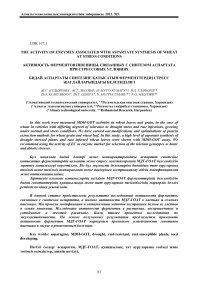The activity of enzymes associated with aspartate synthesis of wheat at stress conditions
Автор: Kudiyarova Zh.s, Lesova Zh.T., Muttucumaru N., Halford N.G.
Журнал: Вестник Алматинского технологического университета @vestnik-atu
Рубрика: Естественные науки
Статья в выпуске: 5 (95), 2012 года.
Бесплатный доступ
In this work were measured MDH-GOT activities in wheat leaves and grain, in the case of wheat in varieties with differing degrees of tolerance to drought stress and rust infections, growing under normal and stress conditions. We have carried out modifications and optimisations of protein extraction methods for wheat grain and wheat leaf. In this study, a high level of aspartate synthesis of drought stressed plants and rust infected wheat leaves were shown with MDH-GOT assay. We recommend using the activity of EC as enzyme marker for selection of the tolerant genotypes to biotic and abiotic stresses.
Asparagine, mdh-got, drought, rust-resistant, rust-susceptible plants, seed developing
Короткий адрес: https://sciup.org/140204974
IDR: 140204974 | УДК: 577.1
Текст научной статьи The activity of enzymes associated with aspartate synthesis of wheat at stress conditions
Asparagine plays a central role in nitrogen storage and transport in plants, due to it’s a high N:C ratio. This involves accumulation in a range of tissues, particularly under stress conditions, including conditions where the plant is unable to support a normal level of protein synthesis.
Asparagine accumulation occurs during normal physiological processes such as seed germination and nitrogen transport; in addition it appears to be induced by abiotic and biotic stresses, such as mineral deficiencies, drought, salt, toxic metals and pathogen attack [1]. The rapid turnover and deactivation associated with plant Asparagine synthetase (AS) make extraction of this enzyme in active form difficult, even in the presence of protectants such as glycerol and thiol-containing compounds [2, 3]. Other difficulties associated with biochemical studies of AS include the presence of endogenous natural inhibitors [4] and relatively high activities of cytoplasmic asparaginase [5] and glutamine synthetase [6], which break asparagine down or compete for similar substrates.
A new potential route for catabolism of glutamate has been identified in wheat [7]. This involves a new stable enzyme complex consisting of malate dehydrogenase (MDH) and glutamate oxaloacetate aminotransferase (GOT/AAT EC 2.6.1.1). This complex (MDH-GOT) catalyses the following reactions: first, MDH catalyzes the oxidation of malate to oxaloacetate, with reduction of NAD to NADH; second, oxaloacetate is transaminated with glutamate to form aspartate and 2-oxoglutarate.
Materials and methods
Protein extraction method for MDH-GOT assay. Wheat leaves or seeds were homogenized in a chilled mortar with Tris-HCL buffer (50mM), pH 7.5, in ratio 1:4 (w/v) and centrifuged at 10 000 × g for 10 min. Protein concentration in the extracts was determined according to Bradford [8].
MDH-GOT enzyme assay. MDH-GOT activity was assayed by measuring the initial rates of reduction of NAD. The increase of absorbance at 340 nm was recorded on spectrophotometer Ultralight. Crude extracts were used for determination of activity of MDH-
GOT and a reaction mixture contained 1.1 mM NAD, 12 mM malate and 8.7 mM glutamic acid, adjusted to 2 ml with 0.05 M Tris - glycine buffer, pH-8.3. The reaction was initiated with the addition of 0.2 ml enzyme extract and malate, measurements were made for 1 minute (A), then glutamate was added and measurements made during another 1 minute (B). The difference of this two measurements (B-A) is the activity of MDH-GOT. The units of enzyme activity are in micromoles of NAD reduced in 1-2 minute per mg of protein in the assay mixture at 25°C.
EC = (∆A340 T0- ∆A340 Tc) MDH -(∆A340 T0- ∆A340 Tc) GOT /ε NADH340x d µM/mole
Where T= time zero, Tc = time when reaction complete, d = dilution, and ε NADH340 = the extinction coefficient of NADH (0.0062 per µM per ml).
Results and discussions
It was proposed that the MDH-GOT complex catalyses the main route of glutamate catabolism without production of toxic ammonia, which would cause cellular damage, and that the activity of the complex correlates with plant adaptation to stress conditions and wheat seed viability [9]. Therefore was measured the activity of MDH-GOT in plants of rust resistant variety Naz and rust susceptible varieties Alexandria, Sappo infected with yellow rust (Puccinia striiformis). Enzyme activity of wheat leaves was measured 14 days after inoculation. Wheat plants with high MDH-GOT activity had higher tolerance to rust infections and the stressed plants had the ability to increase the activity of MDH-GOT as a response to rust infections. Wheat variety Sappo showed more sensitive MDH-GOT activity, so for further experiments it was used as a rust-susceptible plant (Fig.1).
In successfully diseased wheat leaves, MDH-GOT activity was measured every 3-4 days, and this showed gradually increasing activity of MDH-GOT (Fig.2). In leaves from winter wheat cv. Oakley, Little Knott grown in the field, activity of MDH-GOT was almost double that of the control non-infected plants. The activity of the enzyme in rust non-infected plants was not as high as in infected rust-susceptible plants (Fig.3).
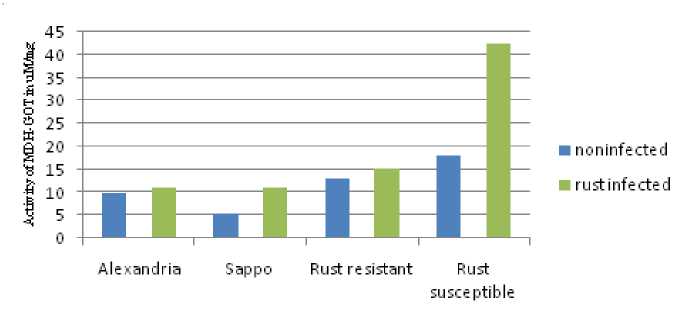
Figure 1 - Activity of MDH-GOT in leaves of rust-resistant wheat variety Naz and rust-susceptible varieties Alexandria and Sappo infected with yellow rust (Puccinia striiformis).
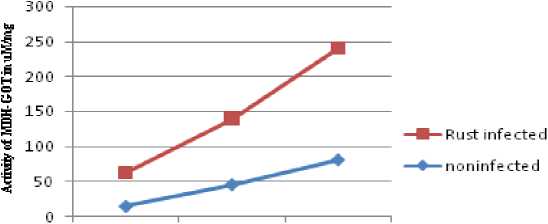
13.07.2011 18.07.2011 22.07.2011
Figure 2 - Changes of activity of MDH-GOT in leaves of rust-susceptible wheat infected with yellow rust.
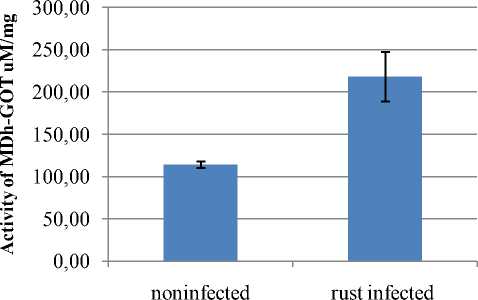
Figure 3 - Activity of MDH-GOT of winter wheat leaf cv. Oakley, Little Knott.
Asparagine is the major transport compound in the xylem from the root to the leaves and in the phloem from the leaves to the developing seeds in a range of plants [10]. Activities of MDH-GOT were measured in leaves and seeds under drought stress at different developmental stages of wheat. In irrigated and non-irrigated wheat plants there wasn’t a big difference, suggesting that the plants were not severely stressed. Activity in both sets of plants increases in the stems after the pre-anthesis stage, when assimilates would be going to the development of seeds (Fig. 4).
The activities of MDH-GOT in nonstressed seeds which were grown in a glasshouse showed low enzyme activities (Fig. 5), while in drought-stressed seeds activity increased sharply during milky stages (Fig. 6).
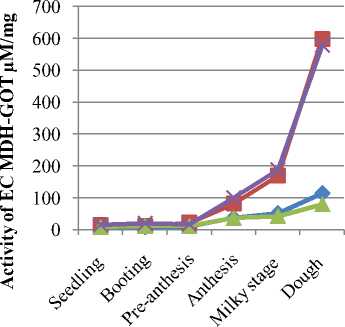
♦ Irrigated plants leaf
-
—■— Irrigated plants stem
-
—*—Non irrigated plants leaf
X Non irrigated plants stem
Figure 4 - Activity of MDH-GOT in leaves and stems of drought-stressed wheat at different developmental stages.
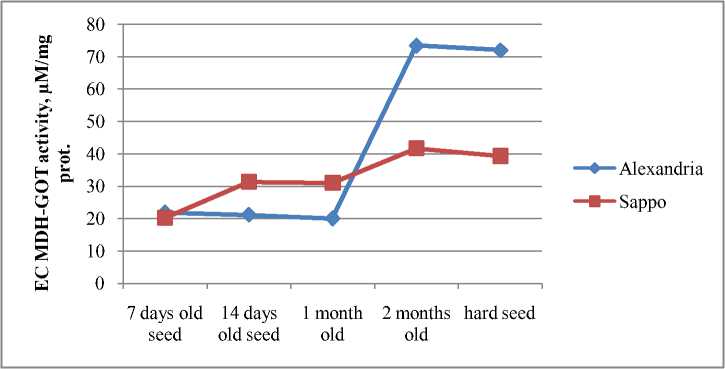
Figure 5 - EC MDH-GOT activities of non-stressed rust susceptible wheat seeds at different developmental stages.
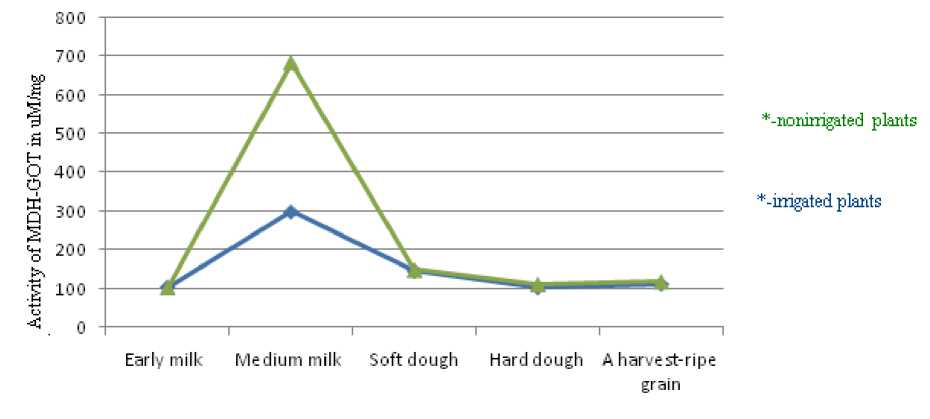
Figure 6 - MDH-GOT activities of drought stressed wheat seeds at different developmental stages.
The MDH-GOT activities did not show a big change during most developmental stages, except that at milky stages the activities were increased and its activity in non-irrigated seeds has been shown to be double that in irrigated seeds, which means the enzyme complex plays an important role during developing and formation of wheat seeds under drought stress.
Conclusion
It has been established that during abiotic and biotic stresses there is an intensive accumulation of ammonia in plant cells. It has also been proposed that asparagine synthetase can use ammonia directly as a substrate [11]. In this study, a high level of aspartate synthesis of drought stressed plants and rust infected wheat leaves were shown with MDH-GOT assay.
In irrigated and non-irrigated wheat plants, there wasn’t a big difference in vegetative organs, such as leaf and stems. In both sets of plants, the activity increased in the stems after the pre-anthesis stage, when assimilates would be going to the development of seeds. During seed development at the milky stage, MDH-GOT activity was higher, and drought stressed seeds showed double the activity of irrigated plant seeds; also MDH-GOT activity was low in non stressed wheat seeds which were grown in the glasshouse.
Wheat plants with high MDH-GOT activity had higher tolerance to rust infections and the stressed plants had the ability to increase the activity of MDH-GOT as a response to drought and rust infections. In rust-infected wheat leaves in the glasshouse, MDH-GOT activity was gradually increasing after 14 days of inoculation and in leaves from winter wheat grown in the field, activity of MDH-GOT was almost double that of control, non-infected plants.
In conclusion MDH-GOT plays an important role during development and formation of wheat seeds and the response to drought.
Acknowledgements
This work was supported by Rothamsted International Fellowship at Rothamsted Research. Authors want to thank Jon West for supplying with rust spores and plants.
Список литературы The activity of enzymes associated with aspartate synthesis of wheat at stress conditions
- Lea, P.J., Sodek, L., Parry M.A.J., Shewry P.R., Halford N.G. (2007) Asparagine in plants. Ann Appl Biol 150. -P. 1-26.
- Joy, K., W.; Ireland, R., J.; Lea, P., J. (1983) Asparagine synthesis in pea leaves, and the occurrence of an asparagine synthetase inhibitor. Plant Physiol., 73. -P. 165-168.
- Snapp, S., S.; Vance, C., P. (1986) Asparagine biosynthesis in alfalfa (Medicago sativa L.) root nodules. Plant Physiol. 82. -P. 390-395.
- Rognes, S., E. (1980) Anion regulation of lupine asparagine synthetase: chloride activation of the glutamine-utilizing reactions. Phytochemistry, 19. -P. 2287-2293.
- Hughes, C., A.; Beard, H., S.; Matthews, B., F. (1997) Molecular cloning and expression of two cDNAs encoding asparagine synthetase in soybean. Plant Mol. Biol., 33. -P. 301-311.
- Sieciechowicz, K. A.; Joy, K., W.; Ireland, R., J. (1988) The metabolism of asparagine in plants. Phytochemistry 27. -P. 663-671.
- Колдасова, А.М., Гильманов, М.К., Шалахметова, Г.А., Цветкова, В. М., Колдасова Ш.M. Методы изучения ферментного комплекса МДГ-ГОАТ необратимого катаболизма глютамата семян пшеницы. -Алматы, 1999. -93с.
- Bradford, M., M. (1976) A rapid and sensitive method for the quantitation of microgram quantities of protein utilizing the principle of protein-dye binding. Anal. Biochem. 72. -P. 248-254.
- Гильманов, М.К., Фурсов, О.В., Францев, А.П. Методы очистки и изучения ферментов растений. -Алма-Ата: Наука, 1981. -91 c.
- Lima, J.D., Sodek, L. (2003). N-stress alters aspartate and asparagine levels of xylem sap in soybean. Plant science 165. -P. 649-656.
- Oaks A., Ross D.W. (1984) Asparagine synthetase in Zea mays. Canadian Journal of Botany, 62. -P. 68-73.

